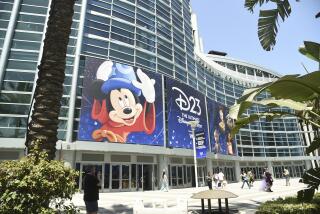Disney Theme Parks Chief Trying to Put a Little Magic in Marketing
- Share via
Walt Disney Co.’s new theme park chief could use a little pixie dust right about now.
In his first three months on the job, Jay Rasulo, the former chief of Disneyland Paris, has seen the travel and tourism business that is Disney’s bread and butter falter once again, just as it seemed ready to bounce back from one of the worst slumps in a decade.
A sagging economy, waning consumer confidence and a possible war with Iraq are forestalling any hopes for a quick turnaround in an industry that was devastated by the Sept. 11 terrorist attacks.
“We continue to be in a period of multiple uncertainties,” Rasulo said in his first in-depth interview since replacing Paul Pressler, who resigned last year to become chief executive of Gap Inc. “We think the comeback will be slow in 2003.”
In such an uncertain climate, the 17-year Disney veteran is trying out some new tricks to lure visitors to the company’s 10 theme parks.
Specifically, Rasulo has set about overhauling his division’s marketing strategy by encouraging more cross promotions among its theme parks worldwide and by better tracking of vacationers’ preferences.
Rasulo also is looking to feature more live productions in the theme parks, such as the new Broadway-style “Aladdin” show at Disney’s California Adventure.
“I see this as an evolution for us in entertainment,” he said.
Industry analysts acknowledge that there’s only so much Disney can do to reverse an industry-wide downturn. Rasulo’s strategy, which comes amid a period of heavy belt tightening, is prudent, they say.
“The idea for live entertainment shows is smart because it’s less risky than putting in a $100-million attraction,” leisure industry consultant Steve Baker said. “I think they’ve squeezed the parks too much. Now they’ve got to get back to concentrating on the show, and that’s what they seem to be doing.”
Rasulo, 47, a New Yorker who is fluent in French and a connoisseur of fine wine, came to his current job after two years as CEO of Euro Disney, where he helped to transform Disneyland Paris into the most popular tourist destination in Europe.
Drawing on his international experience, Rasulo has made it one of his top priorities to change the way Disney markets its parks in Europe.
In Britain, for example, the company is promoting both Disneyland Paris and Walt Disney World in Orlando, Fla., in the same TV advertisements instead of running competing ads. The change saves money and also creates less confusion among consumers, Rasulo said.
Another Rasulo idea: to create global promotion around common Disney characters. “Every one of our parks has a princess,” he said. “Why not blow that into a global theme park initiative for a year?”
Like rival Universal Studios, a unit of Vivendi Universal, Disney has been offering heavy discounts on admissions to locals, recently introducing its first two-parks-for-one promotion through May at Disneyland and California Adventure.
Following a practice common in the lodging industry for years, Rasulo wants to expand Disney’s use of database marketing. Walt Disney World has developed a database called “Destination Disney” that tracks demographics and the vacation choices of its customers.
“This allows us to communicate with our guests and get to know them better so we can create a resort experience tailored to their families’ needs and desires,” Rasulo said.
Analysts applaud the initiative. “Disney has so many different points of contact with consumers that it would be a shame if they didn’t try to harness the intimacy they have with their guests,” said Jordan Rohan, an analyst with SoundView Technology Group.
The new marketing drive comes as Disney takes a breather after a 10-year expansion that Chairman Michael Eisner termed the “Disney decade.”
The expansion continued into the new millennium, with Disney opening three new theme parks in Anaheim, Paris and Tokyo in 18 months.
The overseas push continued last month with the groundbreaking of Hong Kong Disneyland, set to open by 2006. The project represents a steppingstone to tap into the potentially lucrative Chinese market, where Mickey Mouse already is a household name.
Outside of Hong Kong, however, Disney has neither the capital nor the inclination to spend hundreds of millions of dollars building new theme parks over the next decade. Instead, Rasulo said, the company will focus on rounding out existing attractions and finding new ways to entice vacationers.
To that end, Rasulo is pushing for more live entertainment across all of Disney’s properties.
The test case is “Aladdin,” an elaborate, 40-minute stage show produced under the direction of New York theater veteran Anne Hamburger. Based on Disney’s hit animated movie, the stage production is more ambitious in scope and scale than what Disney has previously offered at its theme parks.
The attraction is part of a broader effort to invigorate Disney’s California Adventure, which has struggled to meet attendance projections. If successful, Rasulo said, the show could find venues at other Disney parks and become a model for other Broadway-style versions of classic Disney fare.
Disney hasn’t given up on its big “E-ticket” rides, however.
The company this year will open a $120-million space-flight-simulation attraction at Epcot in Orlando called Mission: SPACE. Next year, California Adventure will add the Twilight Zone Tower of Terror.
“This is a business that we’ve been in long enough,” Rasulo said, “where you evolve and adapt.”
More to Read
The biggest entertainment stories
Get our big stories about Hollywood, film, television, music, arts, culture and more right in your inbox as soon as they publish.
You may occasionally receive promotional content from the Los Angeles Times.











